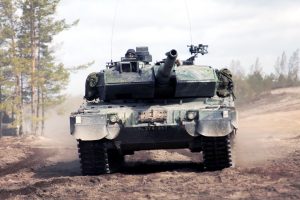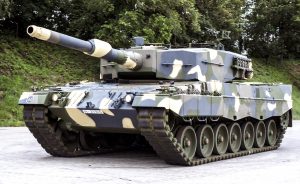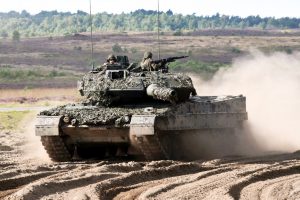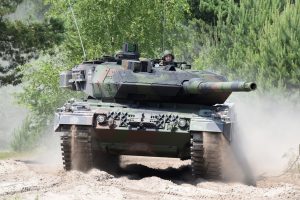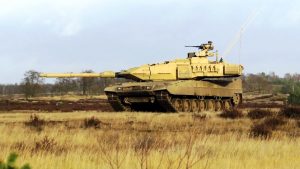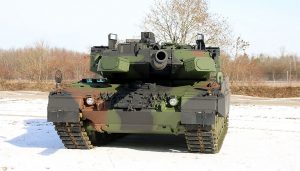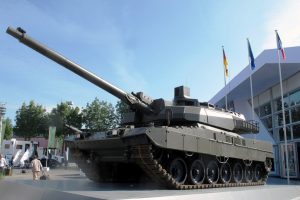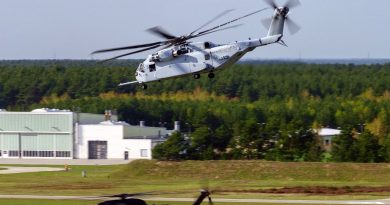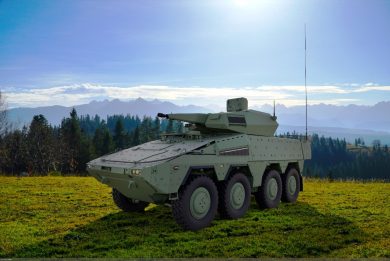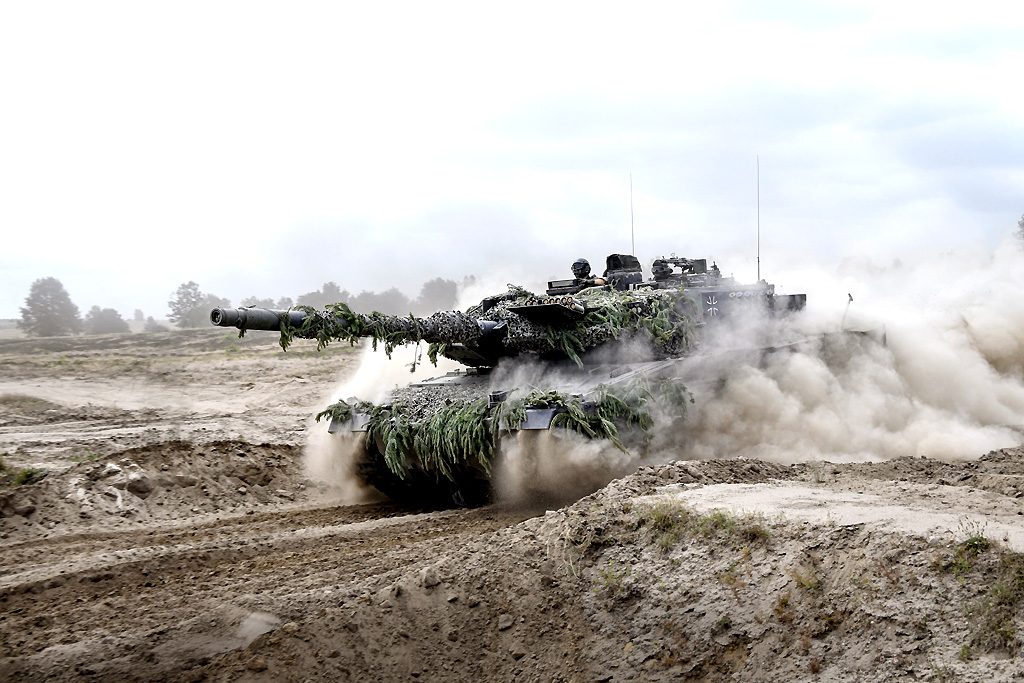
Krauss-Maffei Wegmann: the ever-lasting Leopard 2
By Paolo Valpolini
Fully involved in the bi-national MGCS (Main Ground Combat System) together with Nexter and Rheinmetall, Krauss-Maffei Wegmann (KMW) is nonetheless considering 30 more years of operational life for its Cold War era main battle tank, which is in use or contracted by 19 countries, 14 in Europe, Austria, Denmark, Finland, Germany, Greece, Hungary, the Netherlands, Norway, Poland, Portugal, Spain, Sweden, Switzerland and Turkey, one in north-America, Canada, one in south-America, Chile, one in the Middle East, Qatar, and two in Asia, Indonesia and Singapore.
Many of those tanks were build for the Bundeswehr when NATO was facing the Warsaw Pact threat, and have then been sold to the other nations when the Soviet empire collapsed putting a halt to the Cold War. Along the years KMW launched a series of upgrade programmes based on customers requirements that led from the original Leopard 2 A4 deployed in Central Europe by the German Army and the Netherlands Army in the 1980s, to the Leopard 2 A7A1 that is planned to be delivered to the Bundeswehr.
As the MGCS original timetable for its introduction in 2035 seems currently to be slightly optimistic, the Leopard 2 might remain the main NATO MBT for a while. “I think the MGCS programme needs clear decisions, an established distribution of roles, as well as a real commitment from our two governments,” Frank Haun, CEO of KNDS said on June 21st at the Paris Air Forun.
While new customers, such as Hungary, are acquiring brand new Leopard 2s, intending keeping them in service for a minimum estimated operational life of 20 years, the Munich-based company is already looking forward to extend the effectiveness of its tank minimum till 2040, by integrating new subsystems required by evolving battlefield scenarios, or even to take more radical actions to maintain the key weapon system of many armoured formations at the top of its effectiveness against evolving potential peer adversaries. Visiting the company in Munich, it was worth spending some time to get the latest information on the Leopard 2 evolution and clarify the status of the various upgrade programmes with Rainer Fichtner, the Senior Vice-President of the company MBT Division.
The German Leopard 2 evolution
Derived from A4 and A6 models, the German configuration of the A7 version includes an improved mine protection kit, developed for the A6M version, the addition of a programming unit allowing to fire the DM 11 high explosive ammunition, the adoption of a 3rd generation thermal imager in the commanders periscope, a wholly new man-machine interface based on digital control units, the adoption of the IFIS (Integriertes Führungs- und Waffeneinsatzsystem) battlefield management system, the SOTAS digital IP intercom, a new driver control and information system, a crew compartment cooling system in the turret, and a 20 kW auxiliary power unit allowing semi-silent watch and reducing acoustic and thermal signature when operating stationary.
A key element is the adoption of the Rheinmetall DM 11 round, which thanks to its programmable fuse provides a high operational flexibility, being effective against many types of targets, such as i.e. troops in the open when used in the airburst mode.
“A further step forward has been made with the Leopard 2 A7V. Here the firepower has been further improved with the introduction of the new L55A1 120 mm smoothbore gun which maintains the same chamber volume of the L55 but is cleared to operate at a higher pressure,” Rainer Fichtner tells EDR On-Line. This allows employing the latest kinetic energy ammunition, such as Rheinmetall’s DM73 APFSDS which development is nearly finished and should enter service soon, and the KE2020Neo, under development by the same company, that will provide even higher performances. A new full digital electric gun slaving system has been adopted. The A7V features a new hull which is fitted with improved internal protection modules, while a new protection package has been installed on the chassis roof as well as on the front glacis, bringing the protection of the chassis at the same level of that of the turret. Protection modules can be easily changed to adapt them to the evolving hollow charge threat.
“To cope with the increased weight, compared to the 55 tonnes of the A4 the A7V weighs 64 tonnes, we modified and reinforced the complete running gear, adopting new torsion bars and new tracks. A new final drive was installed, which gives the vehicle the same acceleration from 0 to 30 km/h of the A4, while the top speed is reduced from 70 to 60 km/h, as tactically speaking maximum speed is less important than acceleration at lower speed,” the VP MBT Division explains. The new running gear is designed to withstand up to 69 tonnes combat weight. The gunner WBG-X (Wärmebildgeräte-X) thermal sight has been replaced by a 3rd generation Hensoldt Attica GL, while the driver can now drive forward and backward using the new Spectus multispectral system, also provided by Hensoldt, which combines thermal and low light level cameras, both with the same field of view, the two images being fused according to the situation in order to provide the optimal image. Cooling has been completely reviewed; the A7V features a combined NBC/cooling system in the turret for cooling the electronics and the turret itself, and a separate cooling system in the chassis for the driver.
Qatar has acquired an improved version of the A7V known as A7+ QAT. It features the PERI RTWL, the Hensoldt commander’s periscope in use on the German Puma IFV, which includes a 3rd generation thermal imager, a laser rangefinder and new fibre optic gyros. It allows the commander to survey the battlefield and get target grids that are then handed over along the BMS, i.e. to artillery, if the target cannot be dealt with by the tank itself. Another add-on is KMW’s FLW 200 remotely controlled weapon station, that can be armed with a 12.7 mm machine gun or a 40 mm automatic grenade launcher. Finally the tank is equipped with a meteorological sensor. Qatar is the first nation to field a Leopard 2 fitted with a fully digital fire control system.
Active protection
To answer a Canadian Army requirement, KMW developed an RPG protection kit that was introduced on tanks deployed to Afghanistan. Effective against standard threats as RPG-7, it could not cope with higher threats coming from antitank missiles such as the Kornet. Around six years ago KMW started studying the integration of an active protection system into its MBT. The Leopard 2 parent company considered that passive armour packages reached their limit against the hollow charges threat, current HEAT warheads being able to penetrate over 1,000 mm of rolled homogeneous armour (still the standard reference for penetration, although it is far from being representative of current composite armour) hence it started looking at other solutions. The choice went to the Trophy active protection system, developed by Rafael and installed on Israeli Merkava 4 MBTs. It was initially integrated on a Leopard 2A4, which was used for tests and successfully defeated incoming RPG rockets and anti-tank missiles.
“This development is now finalised, fitted to Leopard 2A6, which when equipped with the APS becomes the Leopard 2 A7A1. The first demonstrator will be delivered to the Bundeswehr in July 2021 and will be tested in different scenarios based on the European reality, such as adverse conditions as dust, rain, snow, urban environment, in order to see how the system reacts in the Old Continent,” Rainer Fichtner said. The four radar antennas are located at the corners of the turret, while the two effectors are installed at the back of the turret, right and left.
The series contract signed in January 2021 calls for the delivery to the German Army of an undisclosed quantity of Leopard 2 A7A1 tanks fitted with the Israeli system. According to available information the order should be for 17 Leopard 2 A7A1 (plus the prototype), sufficient to cover the needs of the tank company assigned to the Bundeswehr contingent that will be provided to the Very High Joint Readiness Task Force (VJTF) in 2023, when Germany will take over the lead of the NATO spearhead force.
Further evolution
Part of the systems already installed in some of the various configurations might well migrate in new upgrade packages. It is the case of the commander’s periscope, KMW considering installing the PERI R17 A4 which is fitted with a Class 1 laser rangefinder.
While a 3rd generation Attica Z thermal camera is now available in the commanders periscope and a similar system has also been fitted to the gunners night sight, KMW is considering a further improvement, stepping from that 640×512 pixel thermal sensor to the full HD 1280×1024 pixel sensor, the Attica M-2. In addition, due to the availability of better and more reliable optronic sighting systems compared to the gunner original WBG-X, a discussion is ongoing about the need to maintain the optical channel.
“Remaining in the thermal sensors arena, in 2020 we evaluated the performances of LWIR (Long Wave InfraRed) against MWIR (Mid Wave InfraRed) to understand if it would make sense to mix different thermal imaging systems, as multiwave sensors in the same TI system are now available. MWIR systems have some advantages over longer distances, but there are issues on the battlefield due to blooming effects. For the European Leopard users, the decision is to remain with LWIR sensors,” Rainer Fichtner said.
Jammers and laser warning systems (LWR) are also part of an ongoing evaluation programme. Jammers used to counter radio-controlled IEDs have already been integrated into Leopard 2s, requirements for such EW systems being foreseeable not only to be used against RC-IEDs but also against drones, one of the increasing threats on today battlefield. As for LWRs, these provide a warning when the tank is illuminated by a laser; if the beam is that from an illuminator or from a beam-riding missile system, the crew can take some evasive action and countermeasures such as multispectral smoke screens can be activated.
KMW is installing different such systems on prototype tanks to allow its customers to carry out a full evaluation of what becomes available on the market.
The future: Leopard 2 Ax, Leopard 2 EDA and E-MBT
With the MGCS entry in service date probably moving to the right, the German Army is considering the next upgrade step for the Leopard 2, which is currently known as Leopard 2 Ax. This will of course take into consideration many of the aforementioned issues, and all requirements will be split between “must” and “option”. “The first decision to be taken is if the turret of the Leopard 2 Ax will be an existing turret submitted to further refurbishment or if it will be a wholly new turret. KMW considers that building a wholly new turret, exploiting new manufacturing techniques and advanced materials, and optimising the design since the early stages, will decrease mass at similar protection level, or will allow increasing protection maintaining the same mass, the most recent iterations of the Leopard 2 turrets being the result of a mass-increasing series of upgrades. “Protection remains a key issue, and we are looking of course at the adoption of reactive armour specifically designed to counter the kinetic energy threat, which is becoming again the main issue considering confrontations with near peer adversaries,” KMWs VP for MBTs said. Further improvements in sensors is required, as well as a wholly digital vetronic architecture, that will allow easy integration of a series of subsystems such as the tracking mode in a fully digital commander’s sight, and improved situational awareness for the driver and commander. The capacity to receive images from UAVs, or even the integration of a UAV as a long range reconnaissance asset, are also foreseen.
Beside the already mentioned MGCS, two more programmes are part of the MBT Division portfolio at KMW. One is the Leopard 2 A7 EDA, the European Defence Agency’s initiative to optimise existing MBT capabilities by pooling and sharing available assets that would offer benefits to all those countries with gaps in their heavy armour portfolio. The programme, launched in spring 2017, foresees the upgrade of existing tanks to a common A7 standard or even its new production, fitted for all options but not with all of them, and then a lease/rent scheme in which those countries with extra armour capacity would provide the tanks to those which lack it, in order to maintain the number of MBTs in Europe at the current level, the number of tanks having decreased from 15,000 to 5,000 in the last 20 years, a further reduction being considered unacceptable at European Union level.
The other programme is the E-MBT, for European Main Battle Tank, made of a Leopard 2 chassis fitted with the Leclerc turret, the latter being equipped with an automatic ammunition loading system, the tank crew being thus reduced to three members. A technology demonstrator of the E-MBT was exhibited at Eurosatory 2018, industry saying at that time that to become a true product it needed some four years from contract signature.
What remains sure is that the Leopard 2 is far from retirement.
Photos courtesy KMW, Finnish MoD, Hungarian MoD, P. Valpolini

